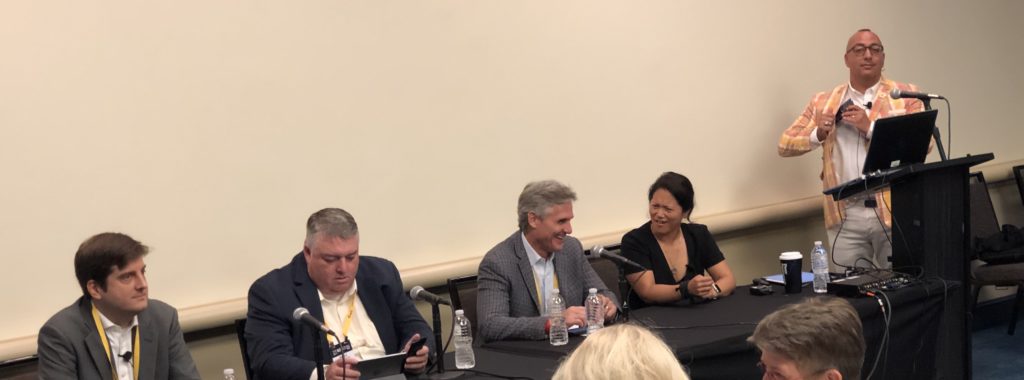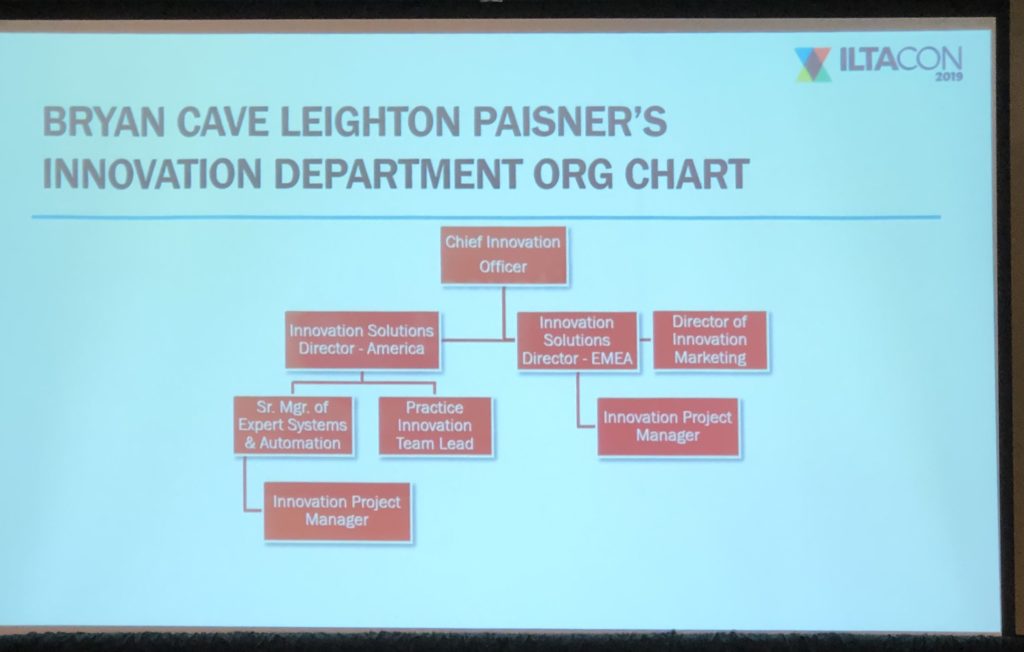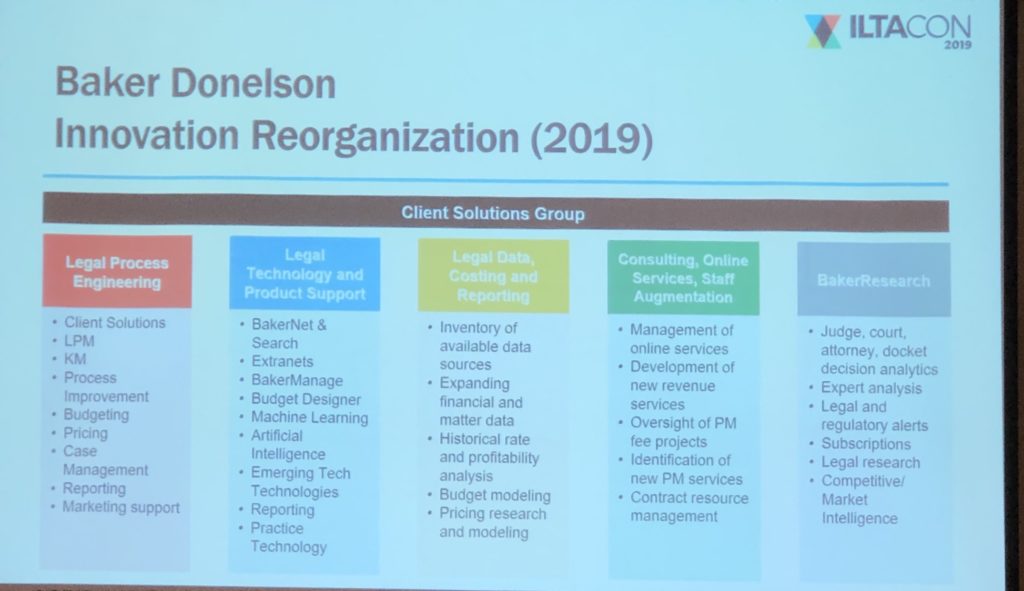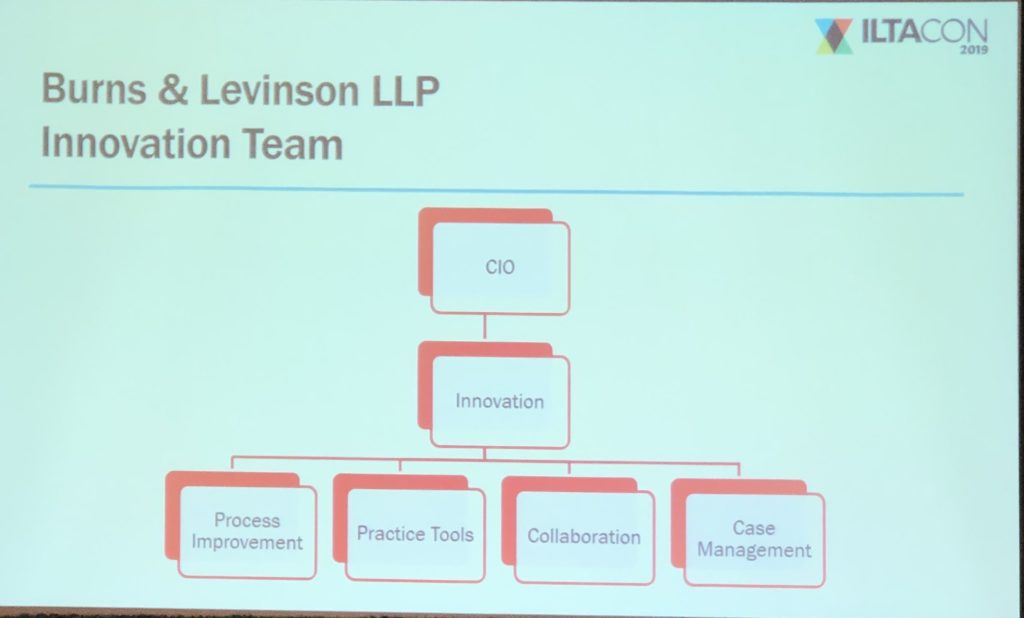This is a live post from the International Legal Technology Association (ILTA) annual conference, ILTACon 2019. This session is Organizing for Innovation, the first of a four part series.
As with all my live posts, please forgive typos and any misunderstanding of meanings. I write this in real time and post as the session ends.
The speakers for this session are:
- Joshua Fireman, President, Fireman & Company
- David Rueff, Shareholder and Chief Client Solutions Officer, Baker Donelson Bearman Caldwell & Berkowitz
- Angela Dowd, Director of Practice Innovation, Burns & Levinson, LLP
- Beau Mersereau, Director, Legal Technology Services, Fish & Richardson P.C.
- Christian Zust, Regional Innovation Solutions Director, Bryan Cave Leighton Paisner LLP

After my session report, I append the session description and takeaways.
Session Report
ORGANIZATION
BCLP. Legacy Bryan Cave combined with legacy Berwin Leighton. There is a formal department (image below) but this department works closely across the firm.

F&R. No formal innovation program. Initial IT department at Fish was too complicated. Two years ago, long-standinutg CIO retired. Beau proposed separating infrastructure from “Legal Technology Solutions”. Made a conscious decision not to use the word innovation because everyone at the firm innovates. This group has 25 people; it includes about one-dozen developers, who build a lot of custome applications, and regularly interact with client. The client interaction is new in last year or two and is very successful. Will re-org again to align more with practices and client services.
Baker Donleson. Heads a new group in the last year to focus on innovation. The firm has three top level departments, LPM, KM, and Research that contribute to innovation. That organization gave way, this year, to the Client Solutions Group with multiple departments reporting up to it:

Burns & Levinson. Angela is an innovation team of one. She works closely across departments. She comes from IT background and, over time, more problems came to her. As partners came to her with problems, she would work with them closely to “what is the real problem you are trying to solve?”

DISCUSSION.
Q: How do you manage interactions with other departments?
Angela: As a team of one, I have to leverage other teams and departments. For example, when I need finance data, I work with head of finance. The interactions are based on trust and shared assumption that we are all working to better the firm. If we run into territoriality, we work through it.
Q: How has combining departments at BD work today and how does that contrast with past?
David: With new firm leadership, we have new ideas on the table. We talk to lawyers and staff who have come to the firm recently to help generated new ideas.
Q: How do you ID the real problem?
Beau: We get napkins with hand-drawn scratches. We have to figure out what’s behind it, to determine the real problem. We have business analysts who work with practices and staff; they bring a wholistic approach, know their customers, and help with the problem definition. And we all try to develop solutions that work for whole firm.
Q: How is your team spread out across your large geo, post merger.
Christian: We are split fairly evenly between US and UK. The type of problems to solve has changed post merger. Pre merger, the innovation department at BC was separated from operational departments. This gave independence but created challenges of selling internally. Now we work with other departments. For example, Cantilever, a separate unit, works closely with clients. My team works closely with them to develop solutions. Now, because our team works regularly with other teams, it’s easier to propagate these solutions.
Q: How does an innovative idea go from ideation to approval (not execution)?
Beau: In the past, there was not a formal process. I worked to change that last year. Now, we evaluate proposals based on rules we’ve developed. If an app will require >$150k, the process is formal; it includes a deep financial analysis for ROI. In the past, we’d think about who would benefit and for how long. That worked until we request volumes dramatically increased – we had to get more formal.
David: We are grappling with formal evaluation now. In past, LPM group that I managed was “on demand.” KM needed bigger tools and so there was a project queue. Now, we are trying to figure out how to combine on demand with the queue. We are moving to a more thorough vetting system where attorneys will need to demo the ROI for client solutions. But internal projects have less formal approvals. Like Fish, however, we are now being inundated with requests. So we need to decide how best to proceed and will have to prioritize.
Beau: in past, if requests were quick (“low code”), we would just try to knock it out. We still do that (in Teams and Power Apps).
Q: Is your team allowed to fail?
Beau: Yes. We will try anything. If you don’t fail, you are not learning. Fish is very good at accepting this. Historically, guardrails have not ruled out new tech. But with bifurcation from IT, we have to be more conscious of security. But we are trying to move to the cloud. (Wrote a white paper on this.)
Q: Pre- and post-combination, what’s changed in how your team approaches the innovation approval process and types of projects on which you work?
Christian: Both legacy firms invested a lot in innovation and were client-driven. BC was tech focused and KM and process were not the strongest points. Legacy BLP had strong KM and process improvement. So now we are learning from each other and both firms can bring their respective virtues to the table. We did not want to lose the ability to fail, or take a quick look. We still have the ability to do that at the outset. But to go to scale, we have a more formal process now. And now, we have several gates. First is an easy hurdle. Subsequent gates are, by design, more involved – and lead to broader impacts.
Q: Many firms wills start with one person “doing innovation”. How doe you designa and execute solutions, with tech and process. Isn’t that hard as one person?
Angela: We get a lot of incoming ideas. I start by looking ideas how fit with firm’s strategic plan. Once I do this, often with CIO, it’s easier to get buy-in from key stakeholders. And once we decide to move forward, many want to be involved.
Q: On working with other departments… note that each has its own plans and budget. How do they get resources to help with innovation initiatives given their other demands?
Christian: Once we get past first hurdle (minimum viable product), we have formal processes to evaluate role and availability of other departments. In the past, we had informal processes for this. Now, we are more formal consultations, so other departments have a say and can plan accordingly. Wee are also influenced by client involvement. Where clients are involved, it helps a lot to move projects forward.
Q: How does client-focused innovation originate? By random attorney? Relationship attorney? And how do you set-up for this; bridge internal function with client side?
David: Ideas evolve in many ways. We go out into the firm and talk about what we’ve done. This gives them ideas. I know from running LPM, many attorneys came in with ideas from clients. Our Clients Solution Group often attends client meetings. We have latitude to work across practices and departments.
Q: Is the client a driver for you?
Angela: Yes, even as army of one, the client is key. I will meet with attorney and their clients. I’m regularly talking to and working with clients.
Beau: One scenario is a new client and we have to scale rapidly. Then we interact with clients. Another scenario is posting more on LinkedIn. Clients read that and it has led to more inquiries and with us meeting more regularly with clients. We continue to create content to post on LinkedIn to help drive client engagement and show our value to the firms.
— Audience Q&A Not Captured —
Session Description
Many law firms and legal departments see the potential in innovation initiatives to help the organization keep pace with client business needs. How do you respond when leadership says “we need to be more innovative?” Which of your firm’s administrative and legal departments should have a seat at the innovation table? Join us in the first session of ILTA’s Innovation Series as we explore how organizations have organized for innovation. We will cover how a firm’s or legal department’s organizational structure can support the ability to move from ideas to action and allow for the execution of innovative solutions quickly.
Takeaways:
- How other firms have established processes to allow the firm to systematically identify business problems, craft solutions, prioritize, and implement these solutions
- How to promote innovative and exciting solutions within your organization
- How to take ownership over a segment of the innovation pie without stepping on toes
- How to staff an Innovation team
Archives
Blog Categories
- Alternative Legal Provider (44)
- Artificial Intelligence (AI) (57)
- Bar Regulation (13)
- Best Practices (39)
- Big Data and Data Science (14)
- Blockchain (10)
- Bloomberg Biz of Law Summit – Live (6)
- Business Intelligence (21)
- Contract Management (21)
- Cool Legal Conferences (13)
- COVID-19 (11)
- Design (5)
- Do Less Law (40)
- eDiscovery and Litigation Support (165)
- Experience Management (12)
- Extranets (11)
- General (194)
- Innovation and Change Management (188)
- Interesting Technology (105)
- Knowledge Management (229)
- Law Department Management (20)
- Law Departments / Client Service (120)
- Law Factory v. Bet the Farm (30)
- Law Firm Service Delivery (128)
- Law Firm Staffing (27)
- Law Libraries (6)
- Legal market survey featured (6)
- Legal Process Improvement (27)
- Legal Project Management (26)
- Legal Secretaries – Their Future (17)
- Legal Tech Start-Ups (18)
- Litigation Finance (5)
- Low Cost Law Firm Centers (22)
- Management and Technology (179)
- Notices re this Blog (10)
- Online Legal Services (64)
- Outsourcing (141)
- Personal Productivity (40)
- Roundup (58)
- Structure of Legal Business (2)
- Supplier News (13)
- Visual Intelligence (14)

